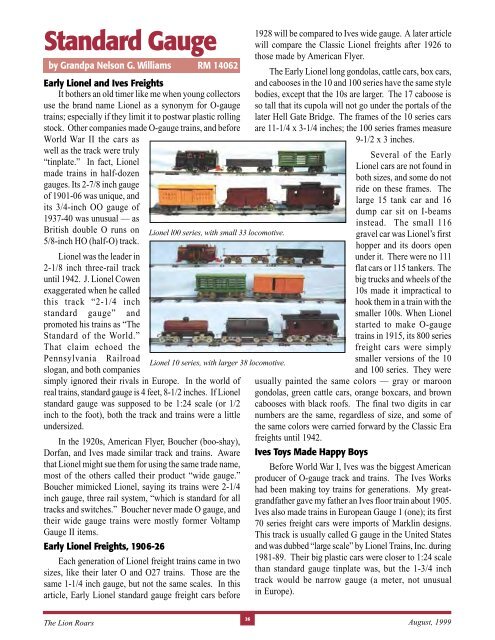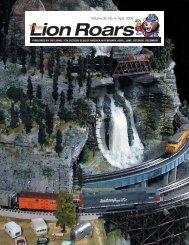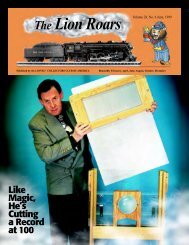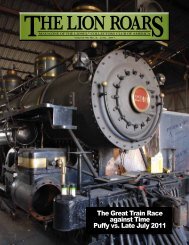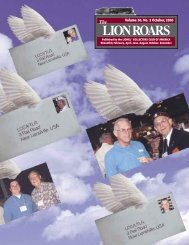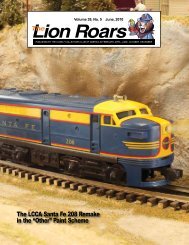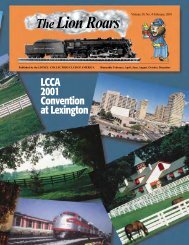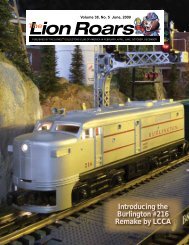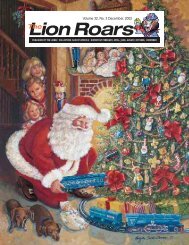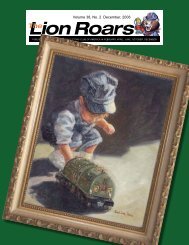The Lion Roars - Lionel Collectors Club of America
The Lion Roars - Lionel Collectors Club of America
The Lion Roars - Lionel Collectors Club of America
You also want an ePaper? Increase the reach of your titles
YUMPU automatically turns print PDFs into web optimized ePapers that Google loves.
Standard Gaugeby Grandpa Nelson G. Williams RM 14062Early <strong>Lion</strong>el and Ives FreightsIt bothers an old timer like me when young collectorsuse the brand name <strong>Lion</strong>el as a synonym for O-gaugetrains; especially if they limit it to postwar plastic rollingstock. Other companies made O-gauge trains, and beforeWorld War II the cars aswell as the track were truly“tinplate.” In fact, <strong>Lion</strong>elmade trains in half-dozengauges. Its 2-7/8 inch gauge<strong>of</strong> 1901-06 was unique, andits 3/4-inch OO gauge <strong>of</strong>1937-40 was unusual — asBritish double O runs on5/8-inch HO (half-O) track.<strong>Lion</strong>el was the leader in2-1/8 inch three-rail trackuntil 1942. J. <strong>Lion</strong>el Cowenexaggerated when he calledthis track “2-1/4 inchstandard gauge” andpromoted his trains as “<strong>The</strong>Standard <strong>of</strong> the World.”That claim echoed thePennsylvania Railroadslogan, and both companiessimply ignored their rivals in Europe. In the world <strong>of</strong>real trains, standard gauge is 4 feet, 8-1/2 inches. If <strong>Lion</strong>elstandard gauge was supposed to be 1:24 scale (or 1/2inch to the foot), both the track and trains were a littleundersized.In the 1920s, <strong>America</strong>n Flyer, Boucher (boo-shay),Dorfan, and Ives made similar track and trains. Awarethat <strong>Lion</strong>el might sue them for using the same trade name,most <strong>of</strong> the others called their product “wide gauge.”Boucher mimicked <strong>Lion</strong>el, saying its trains were 2-1/4inch gauge, three rail system, “which is standard for alltracks and switches.” Boucher never made O gauge, andtheir wide gauge trains were mostly former VoltampGauge II items.Early <strong>Lion</strong>el Freights, 1906-26Each generation <strong>of</strong> <strong>Lion</strong>el freight trains came in twosizes, like their later O and O27 trains. Those are thesame 1-1/4 inch gauge, but not the same scales. In thisarticle, Early <strong>Lion</strong>el standard gauge freight cars before<strong>Lion</strong>el l00 series, with small 33 locomotive.<strong>Lion</strong>el 10 series, with larger 38 locomotive.1928 will be compared to Ives wide gauge. A later articlewill compare the Classic <strong>Lion</strong>el freights after 1926 tothose made by <strong>America</strong>n Flyer.<strong>The</strong> Early <strong>Lion</strong>el long gondolas, cattle cars, box cars,and cabooses in the 10 and 100 series have the same stylebodies, except that the 10s are larger. <strong>The</strong> 17 caboose isso tall that its cupola will not go under the portals <strong>of</strong> thelater Hell Gate Bridge. <strong>The</strong> frames <strong>of</strong> the 10 series carsare 11-1/4 x 3-1/4 inches; the 100 series frames measure9-1/2 x 3 inches.Several <strong>of</strong> the Early<strong>Lion</strong>el cars are not found inboth sizes, and some do notride on these frames. <strong>The</strong>large 15 tank car and 16dump car sit on I-beamsinstead. <strong>The</strong> small 116gravel car was <strong>Lion</strong>el’s firsthopper and its doors openunder it. <strong>The</strong>re were no 111flat cars or 115 tankers. <strong>The</strong>big trucks and wheels <strong>of</strong> the10s made it impractical tohook them in a train with thesmaller 100s. When <strong>Lion</strong>elstarted to make O-gaugetrains in 1915, its 800 seriesfreight cars were simplysmaller versions <strong>of</strong> the 10and 100 series. <strong>The</strong>y wereusually painted the same colors — gray or maroongondolas, green cattle cars, orange boxcars, and browncabooses with black ro<strong>of</strong>s. <strong>The</strong> final two digits in carnumbers are the same, regardless <strong>of</strong> size, and some <strong>of</strong>the same colors were carried forward by the Classic Erafreights until 1942.Ives Toys Made Happy BoysBefore World War I, Ives was the biggest <strong>America</strong>nproducer <strong>of</strong> O-gauge track and trains. <strong>The</strong> Ives Workshad been making toy trains for generations. My greatgrandfathergave my father an Ives floor train about 1905.Ives also made trains in European Gauge 1 (one); its first70 series freight cars were imports <strong>of</strong> Marklin designs.This track is usually called G gauge in the United Statesand was dubbed “large scale” by <strong>Lion</strong>el Trains, Inc. during1981-89. <strong>The</strong>ir big plastic cars were closer to 1:24 scalethan standard gauge tinplate was, but the 1-3/4 inchtrack would be narrow gauge (a meter, not unusualin Europe).26<strong>The</strong> <strong>Lion</strong> <strong>Roars</strong> August, 1999


